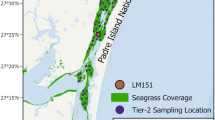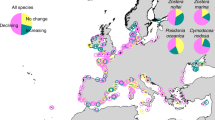Abstract
The Mediterranean Sea, one of the regions warming fastest under climate change1,2, harbours lush seagrass (Posidonia oceanica) meadows that form the basis for a key ecosystem in the region3. Recent field results have shown that increased maximum annual seawater temperature in the Mediterranean has already led to increased seagrass mortality4. Here we project the trajectory of P. oceanica meadows under the warming expected in the western Mediterranean through the twenty-first century to conclude that warming will lead to the functional extinction of P. oceanica meadows by the middle of this century (year 2049±10) even under a relatively mild greenhouse-gas emissions scenario. Efforts to alleviate local stresses adding to the loss of P. oceanica meadows will have a limited effect in conserving the meadows under climate change. Efforts to mitigate climate change are urgently needed to preserve this key ecosystem.
This is a preview of subscription content, access via your institution
Access options
Subscribe to this journal
Receive 12 print issues and online access
$209.00 per year
only $17.42 per issue
Buy this article
- Purchase on Springer Link
- Instant access to full article PDF
Prices may be subject to local taxes which are calculated during checkout


Similar content being viewed by others
References
Bindoff, N. L et al. in IPCC Climate Change 2007: The Physical Science Basis (eds Solomon, S. et al.) (Cambridge Univ. Press, 2007).
Burrows, M. T. et al. The pace of shifting climate in marine and terrestrial ecosystems. Science 334, 652–655 (2011).
Larkum, A. W. D., Orth, J. J. & Duarte, C. M. Seagrasses: Biology, Ecology and Their Conservation (Kluwer Academic Publishers, 2006).
Marbà, N. & Duarte, C. M. Mediterranean Warming Triggers Seagrass (Posidonia oceanica) Shoot Mortality. Glob. Change Biol. 16, 2366–2375 (2010).
Bethoux, J. P. & Copin-Montégut, G. Biological fixation of atmospheric nitrogen in the Mediterranean Sea. Limnol. Oceanogr 31, 1353–1358 (1986).
Hemminga, M. A. & Duarte, C. M. Seagrass Ecology (Cambridge Univ.Press, 2000).
Costanza, R. et al. The value of the world’s ecosystem services and natural capital. Nature 387, 253–260 (1997).
Marbà, N. et al. Assessing the effectiveness of protection on Posidonia oceanica populations in the Cabrera National Park (Spain). Environ. Conserv. 29, 509–518 (2002).
Arnaud-Haond, S. et al. Implication of extreme life span in clonal organisms: millenary clones in meadows of the threatened seagrass Posidonia oceanica. PLoS ONE 7, e30454 (2012).
Marbà, N. & Duarte, C. M. Rhizome elongation and seagrass clonal growth. Mar. Ecol. Prog. Ser. 174, 269–280 (1998).
Marbà, N. et al. Direct evidence of imbalanced seagrass (Posidonia oceanica) shoot population dynamics along the Spanish Mediterranean. Estuaries 28, 53–62 (2005).
Boudouresque, C. F., Bernard, G., Pergent, G., Shili, A. & Verlaque, M. Regression of Mediterranean seagrasses caused by natural processes and anthropogenic disturbances and stress: A critical review. Bot. Mar. 52, 395–418 (2009).
IPCC Special Report on Emissions Scenarios (eds Nakicenovic, N. & Swart, R.) (Cambridge Univ. Press, 2000).
Koch, M. S., Schopmeyer, S., Kyhn-Hansen, C. & Madden, C. J. Synergistic effects of high temperature and sulfide on tropical seagrass. J. Exp. Mar. Biol. Ecol. 341, 91–101 (2007).
Doney, S. C. The growing human footprint on coastal and open-ocean biogeochemistry. Science 328, 1512–1516 (2010).
Duarte, C. M. The future of seagrass meadows. Environ. Conserv. 29, 192–206 (2002).
Hall-Spencer, J. et al. Volcanic carbon dioxide vents show ecosystem effects of ocean acidification. Nature 454, 96–99 (2008).
Hendriks, I. E., Duarte, C. M. & Álvarez, M. Vulnerability of marine biodiversity to ocean acidification: A meta-analysis. Est. Coast. Shelf Sci. 86, 157–164 (2010).
Invers, O., Zimmerman, R., Alberte, R., Perez, M. & Romero, J. Inorganic carbon sources for seagrass photosynthesis: An experimental evaluation for bicarbonate use in temperate species. J. Exp. Mar. Biol. Ecol. 265, 203–217 (2001).
Tomasello, A. et al. Seagrass meadows at the extreme of environmental tolerance: The case of Posidonia oceanica in a semi-enclosed coastal lagoon. Mar. Ecol. 30, 288–300 (2009).
Vizzini, S. et al. Effect of explosive shallow hydrothermal vents on δ13 C and growth performance in the seagrass Posidonia oceanica. J. Ecol. 98, 1284–1291 (2010).
Waycott, M. et al. Accelerating loss of seagrasses across the globe threatens coastal ecosystems. Proc. Natl Acad. Sci. USA 106, 12377–12381 (2009).
Conway, T. & Tans, P. Recent Global Monthly Mean CO2 (NOAA/ESRL, 2011); available athttp://www.esrl.noaa.gov/gmd/ccgg/trends/global.html#global_data.
Parmesan, C. & Yohe, G. A globally coherent fingerprint of climate change impacts across natural systems. Nature 421, 37–42 (2003).
Diaz-Almela, E. et al. Patterns in seagrass (Posidonia oceanica) flowering in the Western Mediterranean. Mar. Biol. 148, 723–742 (2006).
Aires, T. et al. Evolutionary history of the seagrass genus Posidonia. Mar. Ecol. Progr. Ser. 421, 117–130 (2011).
Raitsos, D. E. et al. Global climate change amplifies the entry of tropical species into the Eastern Mediterranean Sea. Limnol. Oceanogr 55, 1478–1484 (2010).
Williams, S. L. Introduced species in seagrass ecosystems: Status and concerns. J. Exp. Mar. Biol. Ecol. 350, 89–110 (2007).
Acknowledgements
This study was financially supported by project SESAME of the 7th Framework Programme of the EU (contract number 036949), projects VANIMEDAT-2 and MEDEICG of the Spanish Marine Science and Technology Program (CTM2009-10163-C02-01 and CTM2009-07013, respectively), the ESCENARIOS project (funded by the Agencia Estatal de Meteorologı´a) and the E-Plan of the Spanish Government. G.J. was supported by a ‘JAE-DOC’ contract from the Spanish Research Council (CSIC).
Author information
Authors and Affiliations
Contributions
G.J., N.M. and C.M.D. conceived and designed the study, discussed the results and wrote the manuscript and Supplementary Information. G.J. wrote the code, ran the model and analysed output data.
Corresponding author
Ethics declarations
Competing interests
The authors declare no competing financial interests.
Supplementary information
Rights and permissions
About this article
Cite this article
Jordà, G., Marbà, N. & Duarte, C. Mediterranean seagrass vulnerable to regional climate warming. Nature Clim Change 2, 821–824 (2012). https://doi.org/10.1038/nclimate1533
Received:
Accepted:
Published:
Issue Date:
DOI: https://doi.org/10.1038/nclimate1533
This article is cited by
-
Reorganization of seagrass communities in a changing climate
Nature Plants (2023)
-
The Dynamics of Seagrass Ecosystems: History, Past Accomplishments, and Future Prospects
Estuaries and Coasts (2023)
-
Status and conservation challenges of the second-largest seagrass bed in India: Chilika lagoon
Environmental Science and Pollution Research (2023)
-
Undisturbed Posidonia oceanica meadows maintain the epiphytic bacterial community in different environments
Environmental Science and Pollution Research (2023)
-
Long range gene flow beyond predictions from oceanographic transport in a tropical marine foundation species
Scientific Reports (2023)



